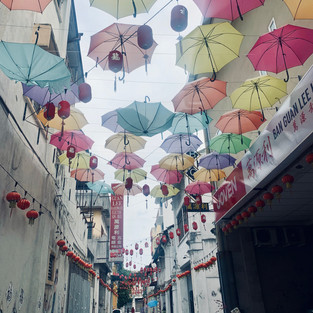Tracing Footsteps in Penang: Georgetown, Malaysia
- mkap23
- Apr 7, 2020
- 9 min read
When we talk to people about our travels, we are inevitably faced with the question, “What’s been your favorite place on this trip?” As you can imagine, this is a hard question to answer; it’s like picking your favorite child, as we’ve truly loved so many places we’ve been for different reasons. But we have to say something, so we offer this next destination as a conversation starter: Georgetown, on the island of Penang in Malaysia. With its diversity of landscapes, architecture, and food, and the palpable energy of its unique culture and people, Georgetown is one of our favorite places visited thus far.
Before we, Emily, and Min Xiu arrived, we briefly stopped over in the town of Ipoh on the way from the Cameron Highlands, which prepared us well for Penang. Resembling a smaller, inland version of Georgetown with no tourists around, Ipoh is fun and livable, boasting a lively Chinatown with cute historic shophouses; a well-preserved colonial district and train station; captivating street art on every wall, from the popular concubine lanes to random parking lots; delicious authentic Chinese food next to trendy modern dishes, such as durian ice cream (yuck); and an abundance of famous Ipoh white coffee (served in a plastic baggie, of course). It’s the type of place where there is not one landmark or experience that defines it, but where the sum of its many small great parts add up to much more. Our time in Ipoh was short (24 hours), but we somehow fit in eight mini meals (to maximize food tasting, of course), a million photoshoots with street art, a thorough historic city walk, a night market, a sunset pool swim, and even a couple loads of laundry.
From Ipoh, we took the high speed train north to Butterworth, then a short ferry ride across the strait to reach Georgetown, the main city and historic center on the island of Penang (just in case you forgot who colonized Malaysia, names like Butterworth and Georgetown should remind you). If Ipoh is a miniature Georgetown, then Georgetown is a [very] miniature Hong Kong—a British enclave built for global trade, located at the base of a lush green mountain, on the coast of a gorgeous island. But, this mini Hong Kong got stuck in the early 1900s, when it was surpassed by Singapore as the Straits Settlements’ main port. Because of this, much of Georgetown’s original shophouses and colonial buildings still remain as they once were, waiting to be explored.

A walk across Georgetown reveals the diversity of the city that makes it such a rich and interesting place to visit. Starting at the northeast corner of the island, at the port where the British originally established the colony near Fort Cornwallis, there are grand government offices, banks, customs houses, and churches fronting a vast open space where the British could play their beloved cricket (now a park). The whitewashed buildings with Greco-like columns felt a bit out of place on the tropical island, and yet, they are beautifully designed and of high quality that we appreciated their contrast with the rest of the island’s architecture.

Strolling south from there along the coast, one reaches the six remaining Chinese clan jetties. When Chinese immigrants initially came to the island, they couldn’t afford to live in the city, so they built informal settlements on the shipping piers where they worked. As they grew wealthier, many families, or clans, upgraded the shantytowns on the piers to formal neighborhoods, with wooden planked streets, plazas, and homes with running water, electricity, and postal addresses. When their numbers grew, they extended the jetties even farther, creating “floating” villages on stilts. Though they are somewhat touristy now, the jetty communities are still very much alive; we saw many families still living and working—many as fishermen—out on the piers that jut out over the Straits of Penang.
Heading inland from the jetties, we came across the walkable, active streets of central Georgetown, lined with a mix of Asian and colonial architecture. Chinese lanterns hang over the streets, providing light to the chatter taking place on the stoops below, a variety of Cantonese that Karen could generally understand. Colorful two-story shophouses, the typical architectural vernacular of colonial-era Malaysia in which shop proprietors live upstairs over their goods, make up most of the buildings here, ranging from dilapidated to exquisitely remodeled. The state of the shophouses today reflect how Georgetown caters to a large tourist population while still maintaining its authentic character. It was not uncommon to see traditional local businesses still thriving alongside re-purposed, tourist-centric shophouses—a printing press next to a guesthouse, or a motorcycle repair shop next to a trendy bookstore. Anchoring the neighborhoods are elaborate Chinese clan houses, which, similar to the ones in Hoi An, act as both temples to honor ancestors and as community centers for the whole clan; today, many feel like headquarters for guild associations or even mafia-like activities. We toured Khoo Kongsi, one of the preeminent clan houses still in use today, featuring an exquisite temple complex with ornate roofs, carved columns, and painted wooden beams.
Down the back alleys of central Georgetown, more secrets can be found. Quiet, unassuming placards point out the historic rooms and buildings where the Chinese revolutionary Sun Yat-Sen, who made his home in Georgetown while he devised plans to overthrow the Qing Dynasty (the last Chinese dynasty) in the early 1900s, held meetings and rallied supporters. And on every corner, murals mixed with interactive 3-D multimedia materials showcased daily life around town: kids reaching out their window for steamed buns as the vendor bikes by, fishermen hawking their daily catch, an old man captaining a rickshaw. Another central theme of the murals may be the strongest argument for why Penang is one of our favorite places: cats. Many of the street art featured feline friends somewhere in the design, if not as the center of attention. But this isn’t just some crazy cat lady drawing graffiti—these artistic masterpieces accurately reflect everyday life in Georgetown just as much as the other murals, since we saw cats at the temples, cats outside our guesthouse, cats outside cafes. There were cats down seemingly every alley we walked through, languid in the afternoon heat, reflecting the slow and steady hum of life in Georgetown. Of course, Karen tried to pet every single one.
Turning the corner, our senses awoke to an energy that couldn’t be suppressed by the heat. We had arrived in Little India! Unlike other “Little” neighborhoods in other cities, Little India in Georgetown is legit. South Indian food stalls serve curries on banana leaves, fresh samosa stands line the streets, and sugarcane stalks are sold for celebrations. The sheer number of Indians walking around is not unlike being in India proper. We watched a sacred cow saunter down the street, crowned with marigold garlands, taking part in a Hindu celebration. As we followed the procession down Lebuh Queen street, past a Hindu temple, we were suddenly exiting Little India, just as quickly as we had arrived. In a melting pot of religious sensory stimulation, the procession turned right onto Jalan Chulia, passing one of the Arabic-style mosques in town as the lighthouse-shaped minaret bellowed out the nightly call to prayer, while incense wafted out onto the street from the Taoist clan house nearby.

Further north in town, we walked to the Blue Mansion, which recently surged in popularity because it was featured in the great mahjong scene in the movie Crazy Rich Asians. But the home was already famous in Malaysia before that, as it was first featured in the appropriately titled movie The Blue Mansion, starring Patrick Teoh—the same man with whom we ate lunch just a week ago in KL! Built in the late 1800s, the Blue Mansion is now a museum and hotel, and is worthy of a visit regardless of its cinematic presence. Built by the wealthy Chinese merchant-trader Cheong Fatt Tze, who made his fortunes building out a vast business empire across East Asia, the mansion’s lavishness knows no bounds, with bright open courtyards and opulent interiors exhibiting classic Chinese Imperial style. It was also designed with perfect feng shei, with part of the mansion raised to be taller than the other side to channel the energy of the building inward, and a fountain in the middle to bring wealth…or something like that.

Not too far away, the second museum-mansion that we visited was the Penang Peranakan Mansion. On the outside, it looks a bit like a New Orleans house in the French Quarter, with pastel colors and iron railing balconies. But on the inside, it was probably even more opulent than the Blue Mansion, with gold motifs and mother-of-pearl inlay in every room and piece of furniture. It even houses its own stunning private temple/ancestral hall, and a museum of Peranakan jewelry and shoes to accompany the massive period parlor rooms, bedrooms, dining rooms, and courtyards. The true richness of the mansion, however, was the fact that—in times when many peoples of mixed ethnicity were often shunned—it celebrated being Peranakan, mixed descendants of Chinese and Malay parents. The Peranakan blended both cultures into a strength and became some of the wealthiest and most respected people in the Straits Settlements.
Wandering through all these Georgetown streets, we were easily seduced by the beauty, artistry, and authenticity of this everyday life. But if we were being honest, the thing that most commanded our attention, was the food.
The food in Georgetown, both the street and sit-down variety, is simply fantastic. Once again, it is the diversity of the population that makes the food so interesting and delicious. We sampled pandan mochi, curry noodle soup, deep fried pork, and fresh steamed vegetables in the street food stalls of Jalan Chulia. We ate ample traditional Cantonese food, including superb dim sum at Tho Yuen, the world’s best wonton mien and mouth-watering sui yook crispy roast pork belly at Hong Kee Wan Thun Mee, and multiple servings of simple but delicious poached chicken and rice for breakfast at the hawker food center near our hotel parking lot. There was also great Peranakan/Malay food, including asam laksa, a spicy curry noodle soup with fish and tamarind, nasi lemak (coconut rice), and chaw kway teow, a seafood fried noodle dish that is similar to Thai pad see ew (but better). Alongside these were also traditional Indian dishes; using our hands, we ate curries ladled from big pots onto banana leaves and snacked on cheap, fresh, delicious samosas and roti. And when we were tired of eating with our hands, we also enjoyed some finer meals at Tek Sen for Chinese, Jawi House for Peranakan, and China House for international tastes, pastries, cocktails, and live music. (For what it’s worth, there is no panang curry in Penang; it must have come from Thailand and/or is an American concoction.)
The sights continued to impress in Penang even outside of Georgetown proper. Taking the steep funicular to the top of Penang Hill, we enjoyed great views of the island and the mainland and hiked one of several walking trails through the temperate jungle forest up on the mountain. There, we came across another important reason why Penang is one of our top destinations so far: monkeys. Not just any monkey—since gray macaques are a dime a dozen in Southeast Asia (except for our one and only Titi)—but Dusky Leaf monkeys. These little stuffed-animal-like monkeys with wide eyes and curious expressions are melt-your-heart cute, and hang out all over the trees on Penang Hill. We spent way too much time just watching the mommas leap from tree branch to tree branch with their orange-fuzz baby Duskys in tow.

Back down at the base of Penang Hill, we also visited the breathtaking Kek Lok Si, a massive Buddhist temple complex that is the largest in Malaysia, and probably the largest Buddhist temple we’ve seen in all of Southeast Asia (despite Malaysia having a smaller Buddhist population compared to its neighboring countries). One enormous hall was lined almost entirely with Buddha statues on its walls; our quick calculations estimated that there were over 6,000 in the building. Size seemed to be a thing at Kek Lok Si, as there was also a giant 120-foot tall statue of Kuan Yin, towering over the city, and an equally tall pagoda with a winding staircase that led to more great views up top. We spent hours at Kek Lok Si, getting lost through its many prayer halls and setting intentions and making wishes for the upcoming Chinese New Year.
The last bit of Penang that we enjoyed—though not for nearly long enough—were stretches of quiet beach on the island’s north coast. Located just a few kilometers from Georgetown, Tanjung Bungah beach provided two hours of warm sun rays, and the perfect tease to lure us back.
On our last night in Georgetown, after five wonderful days there, we went to see the newly-released Malaysian movie, The Garden of Evening Mists. The story is about a relationship between a Chinese Malaysian woman and Japanese man post-WWII, cross-cultural themes that felt ever present during our time in diverse Malaysia. After the movie, we wandered the streets a bit more before heading back to our shophouse hotel, letting Penang slowly shift its way into one of the top spots on our lists of favorites.
Karen & Michael
Ipoh and Penang, Malaysia, January 12-17, 2020
thanks to Min for the wide angle photos!



















































































































Comments